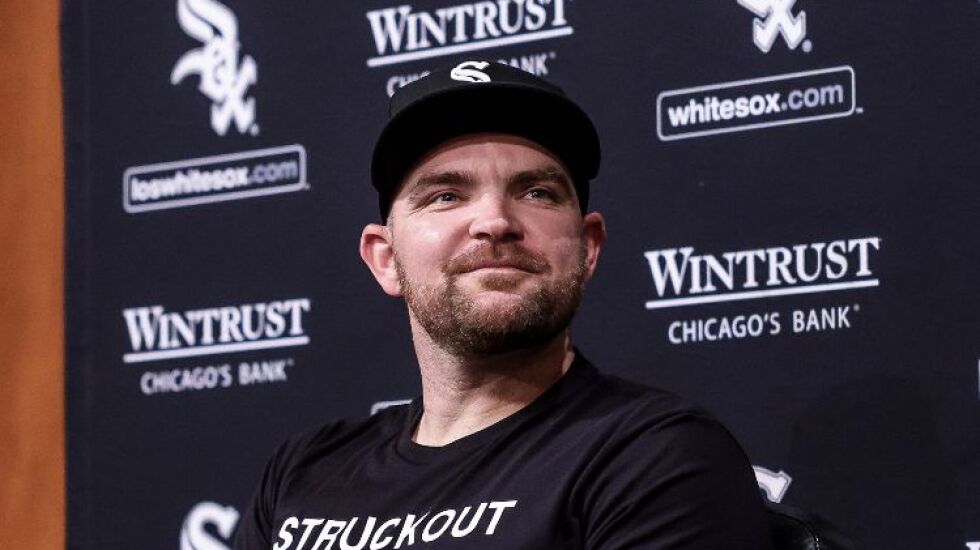
White Sox closer Liam Hendriks isn’t the ‘‘Why me?’’ sort.
So when he was diagnosed with Stage 4 non-Hodgkin’s lymphoma in December, his attitude was more “Why not me?’’ and he attacked it head on.
Five months later, Hendriks sat in a conference room at Guaranteed Rate Field, wearing a STRUCKOUT CANCER T-shirt, his bags packed for a rehab assignment of four or five appearances with Triple-A Charlotte. After that, he’ll be pitching for the Sox again with a clean bill of health — perhaps on their next homestand, which begins May 12.
‘‘It’s hard to put into words,’’ right-hander Lucas Giolito said. ‘‘He’s our closer, one of the best in baseball. So having him back after a rough April, having him coming in and shutting doors in the ninth inning will be hugely important for us.’’
The Sox, who took a 9-21 record without Hendriks into their game Wednesday against the Twins, desperately need him. He is, after all, a two-time American League reliever of the year.
What everyone needs is an injection of inspiration from Hendriks, who matter-of-factly discussed his illness — and how he overcame it — for the first time.
‘‘I never looked at it as a ‘Why me?’ thing?’’ Hendriks said. ‘‘I looked at it as, ‘Why not me?’ I tend to have a more rosy perspective on life than gen pop, so that was my process behind it: ‘I’ve got this. This is my next challenge.’
‘‘I’ve never really had a ‘life is short’ [philosophy] or anything like that. But since my career turned around in 2018, 2019, I haven’t changed my mindset. It’s always been positive. Next day is what we are going to do. It’s never been a look to the future; it’s been taking care of today. That was a contributing factor that really helped me attack everything with this.’’
Hendriks has been throwing bullpen sessions with velocity levels in the 90s, so the expectation is that he can be at or near the levels of performance he has demonstrated in the past. How he recovers from outings, especially early on, will be monitored.
‘‘I don’t plan on regressing,’’ Hendriks said. ‘‘If I go out there [and give up] a hit, I’m still going to be pissed.’’
Hendriks noticed lumps in his neck in June and said the growths in his hips were larger. Blood tests were clean, but he thinks he might have pitched all last season with cancer.
‘‘With the lumps in my neck coming around June, when I got the PET scan done, I looked like a dalmatian, which is not great,’’ he said. ‘‘But it turned out the ones in my hips were actually bigger, so there’s no way to put a real timeline on it. But if I had the ones in my neck in June and the ones in my hips were bigger, there was always the chance I pitched damn near all year with lymphoma in my system.
‘‘I’d like to think that was the reason I struggled to recover and at the end of the year I was damn near limping to the finish line.’’
Manager Pedro Grifol, pitching coaches Ethan Katz and Curt Hasler and numerous teammates, including Michael Kopech, Jimmy Lambert, Kendall Graveman, Andrew Vaughn and Keynan Middleton, attended Hendriks’ news conference.
‘‘What he went through, how he went through it,’’ Grifol marveled. ‘‘Not only did he fight through cancer, he still prepared for this through cancer, which is really incredible. Most people when they are diagnosed with that, that is all they can concentrate on, right? That’s all they think about.
‘‘And not only did he concentrate on that and battle through that, but he still worked at this, which is allowing him to speed that up a little bit now and be here and go through this rehab and hopefully come back here pretty soon.
‘‘He lifts us all up. He’s an inspiration to us all. And just the way he went about it is just incredible.’’







